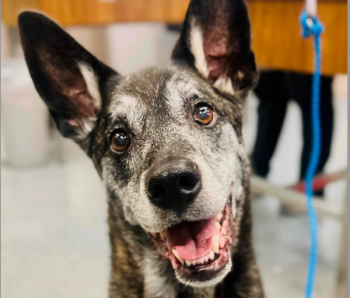
Cancer is the easy part! Techniques to help with difficult clients (Proceedings)
Speaking with pet owners is something veterinarians do constantly; as such, it is the most common "procedure" performed in veterinary medicine. Yet very few veterinarians receive any guidance in this critical area during veterinary school or after.
Speaking with pet owners is something veterinarians do constantly; as such, it is the most common "procedure" performed in veterinary medicine. Yet very few veterinarians receive any guidance in this critical area during veterinary school or after. Does communication matter? Studies in human medicine have shown that the consumer perception of health care quality is highly dependent on the quality of interactions with doctor. Also, the consumer satisfaction levels impact the clinical outcomes (people who liked their doctors did better!). Distressingly, one out of five patients reported a problem communicating with their doctor on most recent visit. Other studies have shown that effective physician-patient communication has been correlated with at least five health outcomes including diagnostic accuracy, improved health status (BP, blood glucose, stress levels, pain management, etc.), improved adherence rates, better patient and physician satisfaction, and decreased malpractice risk.
Good communication allows one to practice better medicine. Improved assessments & diagnosis will occur from acquiring accurate information, understanding the client's concerns and thoughts, actively involving the client in the treatment process, and enhancing the generation of solutions. Improved adherence to your recommendations will occur from better understanding of your client (beliefs, motivation, etc) and empowering the client to be part of treatment team. This will lead to increased preventative care and improved animal health and welfare. Estimates from human medicine on adherence showed that 50% of patients could not recall instructions. Of those that did, only 70% followed them. Veterinarians overestimate adherence, with one study showing average adherence of only 50% for 3 areas:
Client satisfaction/retention is increased with good communication. The client feels respected and valued; this will lead to increased referrals and decreased liability. Practice management improves with improved ability to communicate and manage, improved relationships with colleagues, increased job satisfaction and decreased burnout.
One survey showed that out of a multitude of factors pet owners desire in their veterinarian, the top factor was that the vet be a good listener and communicator, next was being kind and gentle, then respectful and informative, and fourth was reputation for high quality care. Price was selected as #9!
For these multitudes of reasons, communication matters. As such a critical part of the therapeutic success of a veterinarian's efforts, communication is an essential component of the veterinarian's role. It is the vet's responsibility, and it cannot be delegated. Thinking of communication as a procedure will help to understand its importance and place emphasis on the fact that good communication CAN be learned. Like any procedure, mastery requires practice and experience. Too often the ability to talk to people effectively is considered an inherent skill – you either have it or you don't. However, many studies in the field of human medicine have shown that the skills involved in communication are able to be defined and, indeed, learned. There are several constructs upon which to outline and describe techniques in communication. This talk will focus on the four core communication skills.
• Non-verbals
• Empathy
• Open-ended questions
• Reflective listening
Non-verbal communication
Roughly 80% of all communication between individuals is nonverbal and generally unintentional. Thus, information that cannot be hidden is being exchanged at all times – both from the client to the clinician, and vice versa. The nonverbal aspects of communication are like a poker player's "tell" – they give away what a client may be thinking or feeling, possibly contrary to what they are saying verbally.
• Involuntary nonverbal communication more accurately reflects a person's feelings.
• The nonverbal channel is the primary mode of communications of emotions.
• In mixed messages, when verbal and nonverbal communications disagree, the nonverbal channel sends the truer message.
• A common experience is asking a client if they understand, and the client hesitantly says "Yes", often without meeting the clinician's eyes. The non-verbals clearly say the client does NOT understand, and paying attention to that fact and trying to clarify things at that time will often save misunderstanding and upset in the future.
• Nonverbal clues are also extremely useful in communication as they take up no extra time during an interaction. They are going on constantly, and one needs to only consciously note them (and perhaps comment on them, see below) to help guide the discussion in a beneficial manner.
Empathy
Empathy does NOT mean one feels what the client feels, but rather that one can try to imagine what the client has or is experiencing. It is the proverbial "walking in someone else's shoes", and a key point is not only to imagine that experience but to SHOW the client that understanding. Showing empathy is a key part in building rapport with a client. Empathy can be shown in both verbal and non-verbal ways. Three key points of empathy are having a client know that they are being seen, being heard, and being accepted.
• Being seen
1. This means not only physically seen, but seen as an individual person and not just a "client"
2. Comment on unique aspect – clothing, pet's collar, etc
3. Can show this by verbally stating what is seen: "you seem worried", "you look very scared". While this seems awkward or obvious at first, this technique is greatly appreciated by clients.
4. Posture and tone may be used to communicate one's awareness of a client's emotions or concerns
5. Showing a client they are "seen" is tied to reflective listening (see below)
• Being heard
1. Showing empathy by letting a client know they are heard also involves reflective listening (see below)
2. Simply hearing the client is not enough; one must show the client they are heard and understood
3. The process can be thought of as Inhale and Exhale
A. Take in what the client experienced (inhale)
B. Show them your appreciation and understanding of that experience (exhale)
- Verbally and non-verbally
- Our intent or feeling is NOT enough
- Let the client experience our appreciation for their experience
• Being accepted
1. There are several ways in which to help a client feel accepted
A. Non-judgmental
- "You were caught between a rock and a hard place."
B. Normalize:
- "I think anyone who loves their animal the way you do would have reacted that way."
C. Use appropriate self-disclosure:
- "My cat has behavioral issues too"
D. These techniques become even more critical with clients for which it is difficult to feel empathy; verbally showing acceptance via the above phrases can help the client-veterinarian bond even with clients with which it is very hard to bond.
Open ended questions
Open ended questions are very important in obtaining an accurate history. Additionally, they greatly increase the client-veterinarian bond by allowing a client to tell their story – a key part to feeling understood and valued as a person. This "story telling" does not need to be very long or unguided; with specific techniques a veterinarian can guide the answers in situations where they may be too long. Very often, open ended questions SAVE time in an interview, as they allow the veterinarian to understand the true nature of the client's concerns without misleading results that closed-ended questions may provide.
• Closed ended questions
1. Typically begin with Is, Are, Do, Did, Could, Would, Who, When, Where
2. Tend to result in short answers such as yes/no, true/false, one word responses
3. These questions come from clinician's point of view as they take control of the interaction
A. Discourages elaboration by client
4. Useful in
A. Gathering specific information you want to know
B. Clarifying a point
C. Narrowing or limit the area of discussion
D. Managing client anxiety/crisis situation
• Open ended questions
1. Come from client's point of view and invites them to tell their story
2. Responsibility for the interaction is still the clinician!
3. Encourages elaboration by client
4. Typically begin with What or How
A. Avoid Why – carries judgement
5. Tends to focus on client concerns and client's frame of reference
6. Client can use own words/expression without clinician imposed structure
A very helpful way to start the visit with a client is to ask a big, broad questions such as "What has been going on?". If you already know the complaint (e.g., technician took a brief history and the patient is hematuric), an open ended question can still be asked while including the information you have: "So, Fluffy is having blood in her urine. Can you tell me what has been going on?". This technique both allows the client to know that you know their concern, and also allows them to share more and feel that their thoughts are worthwhile. This is a much greater way to improve the clinician-client bond, versus the rapid fire, just-the-facts interrogation technique: "When did you notice the blood? Is she drinking more? Any straining?" etc.
Reflective listening
Reflective listening is the technique, also called active listening, by which an individual "reflects" back what has been said, thus showing interest in and understanding of the meaning of what the speaker is saying. This technique is a key component of showing empathy – one can imagine what another is feeling, but this has no communication benefit if that imagining is not shown to the speaker. Also, reflective listening is an excellent tool for checking understanding.
• Via this technique, the listener repeats back to the client what was said
1. Presents a two-way mirror to client
2. Client sees self, and knows the veterinarian sees the client
3. Client knows s/he is being heard
4. Client can correct, clarify, or add
5. Client can add
• Stems to get reflective statements started
1. "So, you are saying....that you're worried it's something serious....
2. "It sounds like...this is really distressing for you...
3. "You are wondering if....this surgery is a wise decision...
4. "I hear you saying....that you're not sure the medication is worth it...
5. "You are...really struggling with this decision.
• There are three kinds of reflective listening.
1. The most simple form is a short summary and with a rising tone of voice. It is both a statement and a question: "So Friskie threw up twice last night?"
2. The second form offers an interpretation. It often changes the words that the client uses so the clinician is sure that she or he does understand what is being said: "I'm glad that you brought him in today - it sounds like you're really concerned about the breathing changes."
3. The third form involved testing a hypothesis — there is something that is not being said outright, but that the clinician suspects the client is thinking or feeling: "Given your recent experience with Frito, I'm wondering if that's what you're worried about with Two Bit." By showing the wondering, the client can easily confirm, modify, or reject the hypothesis.
• Simple tricks of reflective listening
1. Nods, smiles, mm-hmm's, hand gestures
2. Verbal follow; can simply repeat the last word that was said
A. Client – "Buddy has just been acting strange."
B. Clinician – "Strange?"
• Paraphrasing is one of the most effective listening tools available when one wants to convey to someone that what they are saying is important. It is also an excellent way to verify that what the client has said is correctly understood, which ultimately leads to the improved diagnostic and therapeutic management of the patient.
Summary
By actively employing a few communication techniques in daily interactions with clients (or staff or family and friends!), difficult situations may not only be improved but completely avoided. Employment of these techniques takes concentration – intentional communication is a phrase used to describe this effort. While at first the effort may seem artificial and uncomfortable, the skills (as all learned skills) will grow over time and become a more natural part of one's communication with others.
Newsletter
From exam room tips to practice management insights, get trusted veterinary news delivered straight to your inbox—subscribe to dvm360.






